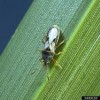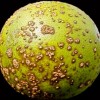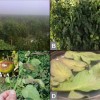 Silicon (Si) is the second most common element on earth, but it is not considered an essential element for plant growth. However, a growing body of evidence has shown that Si can enhance plant resistance to insect pests. This 5-page fact sheet reports the results of a study to determine if silicon applications to St. Augustinegrass varieties increase the silicon in the plants and how this increased silicon affects development and survival of southern chinch bugs as well as development of plant diseases. Written by Alan L. Wright, Ron Cherry, Huangjun Lu, and Pamela Roberts, and published by the UF Department of Soil and Water Science, September 2013.
Silicon (Si) is the second most common element on earth, but it is not considered an essential element for plant growth. However, a growing body of evidence has shown that Si can enhance plant resistance to insect pests. This 5-page fact sheet reports the results of a study to determine if silicon applications to St. Augustinegrass varieties increase the silicon in the plants and how this increased silicon affects development and survival of southern chinch bugs as well as development of plant diseases. Written by Alan L. Wright, Ron Cherry, Huangjun Lu, and Pamela Roberts, and published by the UF Department of Soil and Water Science, September 2013.
http://edis.ifas.ufl.edu/ss589
Tag: P.D. Roberts
Disease Control for Florida Tomatoes (PPP35/VH056)
 Successful disease management has always been vital in Florida tomato production, given the generally ideal environmental conditions for most plant diseases. An integrated disease management program is a successful approach. This 7-page fact sheet was written by Mathews Paret, Ken Pernezny, and Pam Roberts, and published by the UF Department of Plant Pathology, August 2013.
Successful disease management has always been vital in Florida tomato production, given the generally ideal environmental conditions for most plant diseases. An integrated disease management program is a successful approach. This 7-page fact sheet was written by Mathews Paret, Ken Pernezny, and Pam Roberts, and published by the UF Department of Plant Pathology, August 2013.
http://edis.ifas.ufl.edu/vh056
Informacion para los propietarios: Cancro Citrico (PP298)
 El cancro cítrico es una enfermedad introducida en Florida y es muy perjudicial económicamente para la industria comercial. La enfermedad no está presente en todas las regiones tropicales y subtropicales productoras de cítricos donde el cancro cítrico puede ser problemático, por lo tanto, las restricciones para exportar fruta con cancro cítrico son muy estrictas. Esta enfermedad también concierne a los propietarios, no solo por sus efectos en la industria económica, sino también porque es altamente contagiosa y la mayoría de la fruta contagiada en un árbol muy afectado se cae de éste prematuramente. This 4-page fact sheet was written by M. M. Dewdney, P. D. Roberts, J. H. Graham, K. R. Chung, and M. Zekri, and published by the UF Department of Plant Pathology, January 2013.
El cancro cítrico es una enfermedad introducida en Florida y es muy perjudicial económicamente para la industria comercial. La enfermedad no está presente en todas las regiones tropicales y subtropicales productoras de cítricos donde el cancro cítrico puede ser problemático, por lo tanto, las restricciones para exportar fruta con cancro cítrico son muy estrictas. Esta enfermedad también concierne a los propietarios, no solo por sus efectos en la industria económica, sino también porque es altamente contagiosa y la mayoría de la fruta contagiada en un árbol muy afectado se cae de éste prematuramente. This 4-page fact sheet was written by M. M. Dewdney, P. D. Roberts, J. H. Graham, K. R. Chung, and M. Zekri, and published by the UF Department of Plant Pathology, January 2013.
http://edis.ifas.ufl.edu/pp298
Late Blight of Potato and Tomato (PP301)
 Both potato and tomato are susceptible to late blight, an aggressive disease capable of rapidly destroying entire fields. The disease is distributed worldwide and occurs wherever tomatoes or potatoes are grown and conditions favor disease development. This 4-page fact sheet was written by Ryan Donahoo and Pamela Roberts, and published by the UF Department of Plant Pathology, December 2012.
Both potato and tomato are susceptible to late blight, an aggressive disease capable of rapidly destroying entire fields. The disease is distributed worldwide and occurs wherever tomatoes or potatoes are grown and conditions favor disease development. This 4-page fact sheet was written by Ryan Donahoo and Pamela Roberts, and published by the UF Department of Plant Pathology, December 2012.
http://edis.ifas.ufl.edu/pp301
Identificacion de los sintomas del cancro citrico y procedimientos de descontaminacion (PP214SP/PP138)
 El cancro cítrico es una seria enfermedad de los cítricos. La mayoría de los cultivos de cítricos son susceptibles, la toronja, la lima mejicana y algunas naranjas tempranas son las más susceptibles. Una infección severa puede causar defoliación, una muerte regresiva de la rama, una decadencia general del árbol, una caída prematura de la fruta, y manchas en la misma. Los árboles severamente infectados se vuelven débiles, improductivos y no rentables. This 5-page fact sheet was written by Mongi Zekri, Megan Dewdney, Jamie Burrow, and Pamela Roberts, and published by the UF Department of Plant Pathology, August 2012.
El cancro cítrico es una seria enfermedad de los cítricos. La mayoría de los cultivos de cítricos son susceptibles, la toronja, la lima mejicana y algunas naranjas tempranas son las más susceptibles. Una infección severa puede causar defoliación, una muerte regresiva de la rama, una decadencia general del árbol, una caída prematura de la fruta, y manchas en la misma. Los árboles severamente infectados se vuelven débiles, improductivos y no rentables. This 5-page fact sheet was written by Mongi Zekri, Megan Dewdney, Jamie Burrow, and Pamela Roberts, and published by the UF Department of Plant Pathology, August 2012.
http://edis.ifas.ufl.edu/pp138
Field Identification of Citrus Canker Symptoms and Decontamination Procedures (PP214/PP136)

Citrus canker, caused by the bacterial pathogen Xanthomonas citri subsp. citri, is a serious disease of citrus. The disease causes necrotic dieback, general tree decline, premature fruit drop, and fruit blemishes. Severely infected trees become weak, unproductive, and unprofitable. Learn how to identify citrus canker and proper procedures for decontamination with this 5-page fact sheet written by Mongi Zekri, Megan Dewdney, Jamie Yates, and Pamela Roberts, and published by the UF Department of Plant Pathology, July 2011.
http://edis.ifas.ufl.edu/pp136
Recommendations for Management of Whiteflies, Whitefly-transmitted viruses, and Insecticide Resistance for Production of Cucurbit Crops in Florida (EENY478/IN871)
 Until recently, squash has been the only cucurbit crop seriously affected by the B biotype of the sweetpotato whitefly, also known as the silverleaf whitefly, because of the silverleaf disorder induced by feeding of the immature stages (nymphs). However, three viruses transmitted by the whitefly have been identified in watermelon, muskmelon, and squash in Florida since 2004, making whitefly management a priority for most cucurbits. This 8-page fact sheet details the current UF/IFAS recommendations for managing whitefly-transmitted viruses and for delaying the development of resistance to insecticides in the whitefly vector. Published by the UF Department of Entomology and Nematology, July 2011.
Until recently, squash has been the only cucurbit crop seriously affected by the B biotype of the sweetpotato whitefly, also known as the silverleaf whitefly, because of the silverleaf disorder induced by feeding of the immature stages (nymphs). However, three viruses transmitted by the whitefly have been identified in watermelon, muskmelon, and squash in Florida since 2004, making whitefly management a priority for most cucurbits. This 8-page fact sheet details the current UF/IFAS recommendations for managing whitefly-transmitted viruses and for delaying the development of resistance to insecticides in the whitefly vector. Published by the UF Department of Entomology and Nematology, July 2011.
http://edis.ifas.ufl.edu/in871
PP194/PP116 Homeowner Fact Sheet: Citrus Canker
Revised! PP194, a 4-page illustrated fact sheet by M.M. Dewdney, P.D. Roberts, J.H. Graham, K.R. Chung, and M. Zekri, informs homeowners about this serious disease of citrus, its history, symptoms, spread, and control strategies. Published by the UF Department of Plant Pathology, October 2009.
http://edis.ifas.ufl.edu/PP116
PP271 Downy Mildew of Basil in South Florida
PP271, a 3-page illustrated fact sheet by Shouan Zhang, Pamela D. Roberts, and Richard Raid, describes this new destructive disease that results in yellowing and cupping of the leaves of basil and ornamental plants related to it — distribution, symptoms, and control. Published by the UF Department of Plant Pathology, September 2009.
http://edis.ifas.ufl.edu/PP271
PP113 2006 Florida Plant Disease Management Guide: Sweet Basil
Revised! PP-113, a 2-page fact sheet by Shoan Zhang and Pamela D. Roberts, describes the symptoms and cultural controls for four plant diseases common to Sweet Basil in Florida — downy mildew, leaf spot, bacterial leaf spot, and fusarium wilt. Published by the UF Department of Plant Pathology, March 2009.
http://edis.ifas.ufl.edu/PP113
PPP6/PG100 2008 Florida Plant Disease Management Guide: Chemical Control Guide for Diseases of Vegetables, Revision No. 19
Revised! PPP-6, a 108-page publication by Ken Pernezny, Amanda Gevens, Tim Momol, Aaron Palmateer, Natalia Peres, Richard Raid, Pam Roberts, Gary Vallad, and Shousan Zhang, is a guide to lawful use of sprayable chemicals intended for control of plant diseases affecting vegetables grown in Florida. Published by the UF Department of Plant Pathology, September 2008.
http://edis.ifas.ufl.edu/PG100
ENY501/IN788 Educate to Detect: Conducting First Detector Training in Florida
ENY-501, a 5-page fact sheet by Amanda Hodges, Jennifer Gillett-Kaufman, Carrie Harmon, Aaron Palmateer, Pamela Roberts, Adrian Hunsberger, Sylvia Shives, Theresa Friday, and Jiannong Xin, answers questions about the NPDN First Detector training program, which promote the early detection and proper identification of potentially devastating exotic species through a coordinated extension education effort. Includes references. Published by the UF Department of Entomology and Nematology, December 2008.
http://edis.ifas.ufl.edu/IN788
RFSR007/SR007 Sample Submission Guide for Plant Diagnostic Clinics of the Florida Plant Diagnostic Network.
Revised! RF-SR007, an 8-page guide by A.J. Palmateer, C.M. Stiles, P.D. Roberts, R.E. Cullen, H. Dankers, R.J. McGovern, N. Peres, P.F. Harmon, and C.L. Harmon, provides extension clientele with the information they need to submit plant samples to Florida Extension Plant Diagnostic Clinics. Published by the UF Department of Plant Pathology, May 2008.
http://edis.ifas.ufl.edu/SR007